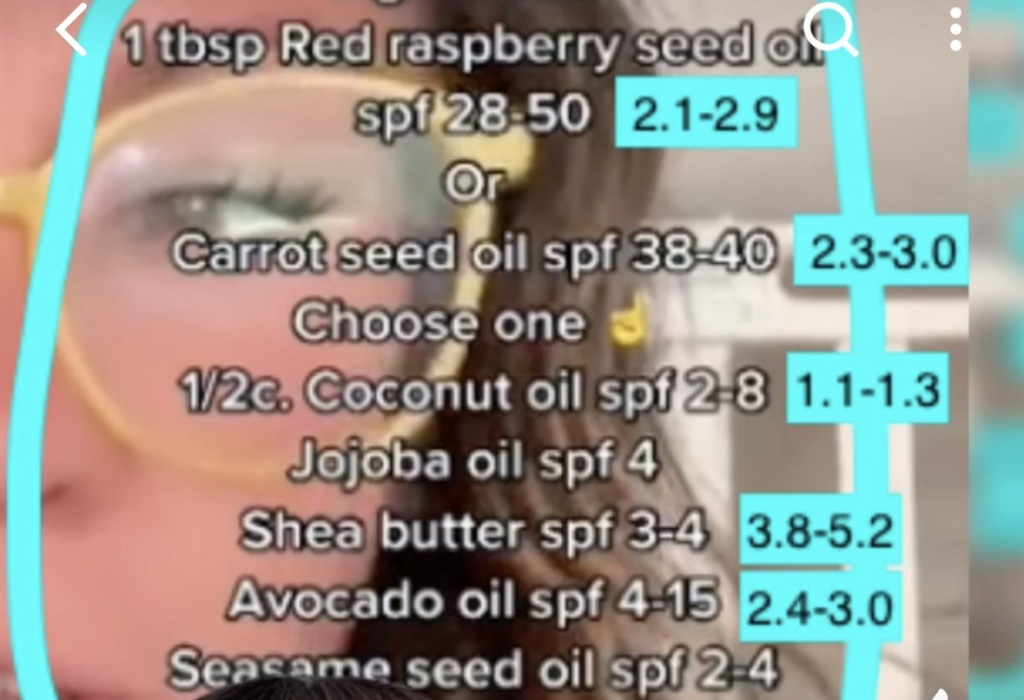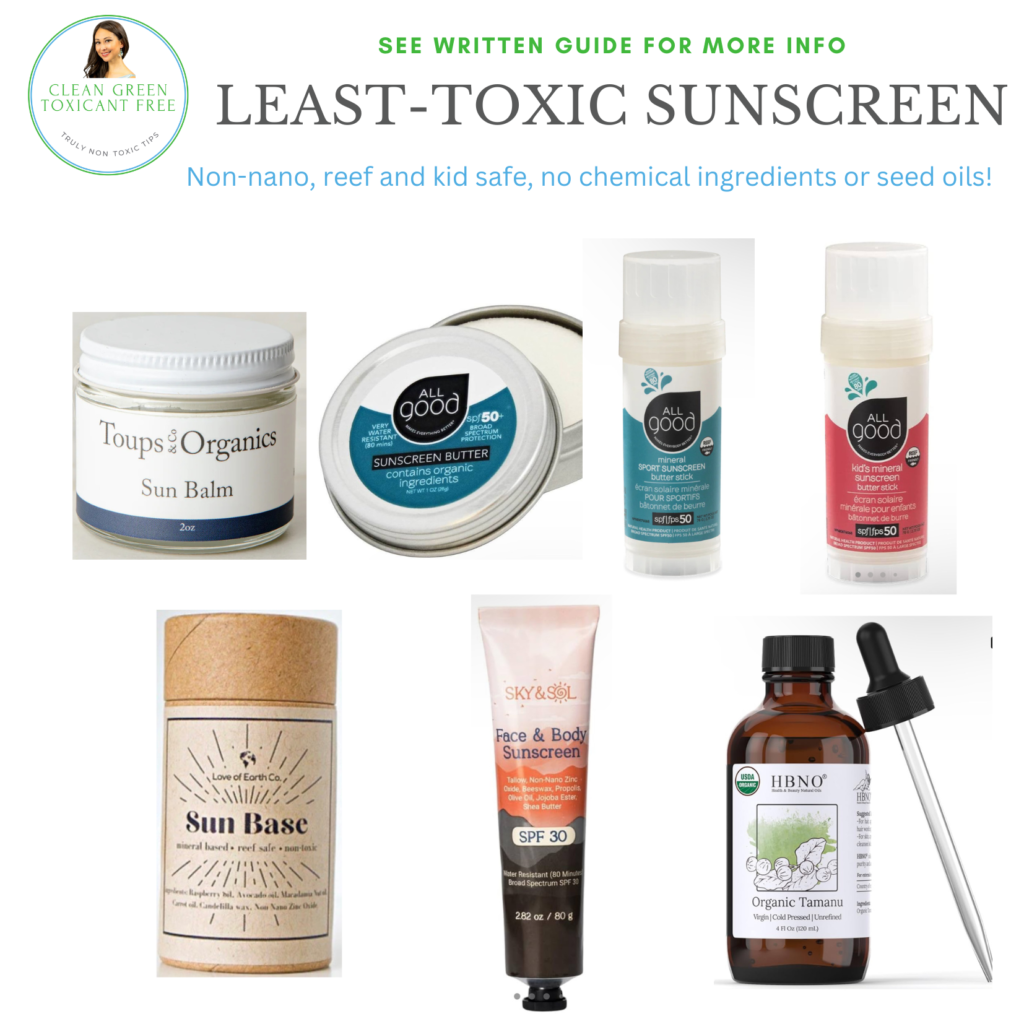
This post is NOT sponsored in any way, and I don’t sell any products such as MLM. I did this investigation to find sunscreen for my kids and I to use. Therefore, I was very personally invested in finding the least toxic options!
This post may contain Amazon Associates or other affiliate links, that I may earn small amounts from if you click them. This doesn’t create bias because I make my recommendations based solely on toxicity, and not based on a payment from specific products. See the bottom of this page for more details.
Natural Sunscreen Myths
Have you heard that there was a study that showed that zinc oxide sunscreen turns ineffective and toxic after 2 hours? Well, don’t worry about that, because that is ONLY if it is combined with with the chemical sunscreen ingredients, which I would never recommend.
Have you also heard that natural oils (raspberry, carrot seed, etc) have spf? Unfortunately that has been proven to not be as great as we hoped, and has shown in a published research article most of the oils have very low spf; and lower than popularly reported.
The highlighted numbers are what was purportedly proven by the study. The other numbers have been falsely claimed to be higher spf than they really are:

Types of Sunscreen and Risks
A little background into commercially sunscreens is that there are basically two types: Physical/ mineral OR chemical (namely avobenzone or oxybenzone).
Mineral sunscreens usually contain zinc oxide. Look for one explicitly labeled as “non-nano.” Also, avoid mineral sunscreen that contains titanium dioxide (there are definite risks of inhaling this in loose form; but even when contained in a cream, it can be absorbed through the skin). Be aware that zinc is always a risk for containing lead, but applied topically and non-nano is less risky for absorption. I apply it with a makeup brush so that it doesn’t get on my fingertips and then spread to items or in my mouth. I am trying to get information from the products I recommend to see if they have testing for heavy metals.
A Healthline article states: “A 2020 study found that 6 of 12 active ingredients [in sunscreen are] currently under study by the FDA enter the bloodstream after just one application. These ingredients remain detectable in the blood and on the skin up to 3 weeks later — at concentrations passing the threshold where the FDA considered waiving additional safety trials.
While some have expressed concerns that certain chemicals in sunscreen, particularly oxybenzone and octinoxate, might disrupt certain endocrine functions, recent research hasn’t found conclusive evidence of adverse health outcomes related to sunscreen.
Another potential drawback of chemical sunscreens: People with sensitive skin may experience an unwanted reaction, like redness or inflammation. Some ingredients could exacerbate skin conditions like rosacea or melasma… people with sensitive skin will likely do better with a physical sunscreen, since it poses a lower risk of irritating your skin.
Some of the active ingredients in chemical sunscreens — notably oxybenzone, octocrylene, and octinoxate — have been associated with dying coral reefs. Coral reefs can also absorb nanoparticles, or very tiny particles, from sunscreens, regardless of ingredients.
If eco-friendliness is a requirement for your sunscreens, your best bet is a mineral sunscreen that’s explicitly labeled as containing no nanoparticles. This typically means choosing a lotion over a mist or spray.”
Spray sunscreens have additional toxicity concerns from inhalation risks!
Least Toxic Sunscreen Options
Although the research about seed oils on the skin is limited and conflicting, seed oils are heavily processed and are extremely detrimental to ingest. And so recently I have decided to avoid those types for my skin too. Therefore, none of my recommendations contain seed oil. However, if your otherwise natural sunscreen contains some seed oils, I wouldn’t worry too much, as some types of seed oil can have beneficial properties for skin.
-If you do want one of the natural sunscreen alternatives, Tamanu oil or Shea butter are the highest spf, but I can’t access the full journal article to see the exact spf. According to this site, tamanu oil offers an SPF of 18-22 depending on specific variables. I bought this tamanu oil to use for everyday type of use (I also always wear a hat outside) but wouldn’t count on any oil or shea butter if you are going to the beach or going to be getting any significant sun exposure. https://amzn.to/4f05NR5 (Amazon Associates Link).
The rest of the options I am sharing all contain zinc oxide. Note that some of them are not vegan, so read all the ingredients to make sure you are ok with them.
-After much investigation and consideration, I will be trying this Sun Balm from Toups and Co. It comes in a glass jar, which is the least toxic type of packaging. The brand explains that “Coconut co2” is not coconut oil, but rather is an extract that contains richer properties and more medium chain fatty acids. It also contains vanilla, so it will smell nice. Ingredients: Grass-fed tallow, organic olive oil, 20% non-nano zinc-oxide, coconut co2, vanilla extract. This brand says they are “third party tested for heavy metals” and products tested were less than 1 parts per million (100 ppb) for Cadmium, Lead, and Mercury.
-All good SPF50 Mineral Sunscreen Butter is the cheapest and most easily accessible option on my list, and I will probably try it for my kids. However I wouldn’t use it on my own face because it contains coconut oil, which can clog my pores. Some people don’t have that issue, and I explain it in this post. ACTIVE INGREDIENT: Zinc Oxide 25% (Non-nanoparticle). INACTIVE INGREDIENTS: Organic Cocos Nucifera (Coconut) Oil, Organic Cera Alba (Beeswax), Organic Calendula Officinalis (Calendula) Flowers infused in Organic Simmondsia Chinensis (Jojoba) Seed Oil, Non-GMO Tocopherol (Vitamin E). Amazon Associates link to the product: https://amzn.to/3Y3sv4n. The stick version has the same ingredients: https://amzn.to/3S9u5yd. (Amazon Associates Links).
-All Good Baby & Kids Sunscreen Stick has similar ingredients: ACTIVE INGREDIENT: Zinc Oxide 25% (Non-nanoparticle). INACTIVE INGREDIENTS: Calendula Officinalis (Calendula) Flowers*, Cera Alba (Beeswax)*, Chamomilla Recutita Matricaria (Chamomile) Flower Extract*, Cocos Nucifera (Coconut) Oil*, Simmondsia Chinensis (Jojoba) Seed Oil*, Non-GMO Tocopherol (Vitamin E). https://amzn.to/464UAdD.(Amazon Associates Link).
-Sun Base by Love of the Earth Co. is another I would try. It would be even better if the ingredients were organic. It is packaged in a 100% compostable case. Ingredients: Raspberry oil, Avocado oil, Macadamia Nut oil, Carrot oil, Candelilla wax, Non Nano Zinc Oxide (this product is unscented).
-Sky and Sol Natural Mineral Sunscreen on Amazon has organic ingredients, but I did ask about the packaging because the packaging tube is made of aluminum. The company said these tubes have an “inert and safe epoxy resin interior coating” but for me personally I will opt for a product with different packaging. Ingredients: Organic 100% Grass-Fed Tallow, Cold-pressed Jojoba , Non-Nano Zinc Oxide, Organic, Cold-Pressed Olive Oil, Propolis, Sustainable Organic Beeswax, Organic Shea Butter. https://amzn.to/4f6Pqlq (Amazon Associates Link).
Alternatives to Sunscreen
Sunscreen isn’t the only way to protect your skin from the sun. Adapted from Healthline:
- Clothing and hats. Cover your skin with long-sleeved tops and pants, and don’t forget a wide-brimmed hat to shield your face and neck. You can shop for UV-resistant or UV-protective clothing, but be careful to get ones that provide protection due to the tight weave of the fabric, NOT ones that have been coated with a chemical SPF treatment.
- Timing. Peak sunshine hours are between 10 a.m. and 4 p.m. Aim to spend time outdoors before or after this period whenever possible, and make a point of staying in the shade when you can. Also be aware that even beach tents don’t offer protection from the rays of the sun, and if you are sitting near the edge of the shade, rays can reflect off the sand or ground and be directed up at you even if you seem to be in the shade, away from direct sunlight.
- Avoid UV lights. Yes, including tanning beds and sunlamps.
- Another thing I have but haven’t tried yet are these stickers that block sun rays, but I feel these would only work well on the cheeks. https://amzn.to/4cikBIO
PLEASE follow my Facebook page for new posts and updates. Thank you!
***Thank you for visiting Clean Green Toxicant Free! I started this site simply because I want to help people and share information. I dig deep tand seek the most truly non-toxic products, without bias. I am not paid to write anything and I don’t sell anything. In 2022 (years after establishing my site) I became an Amazon Associate, which does NOT bias my recommendations. I may earn small dividends from purchases made after clicking my clearly labeled links (even if you don’t buy those specific items), which is used to cover the costs of maintaining this site. More info is on the About This Website page.***

